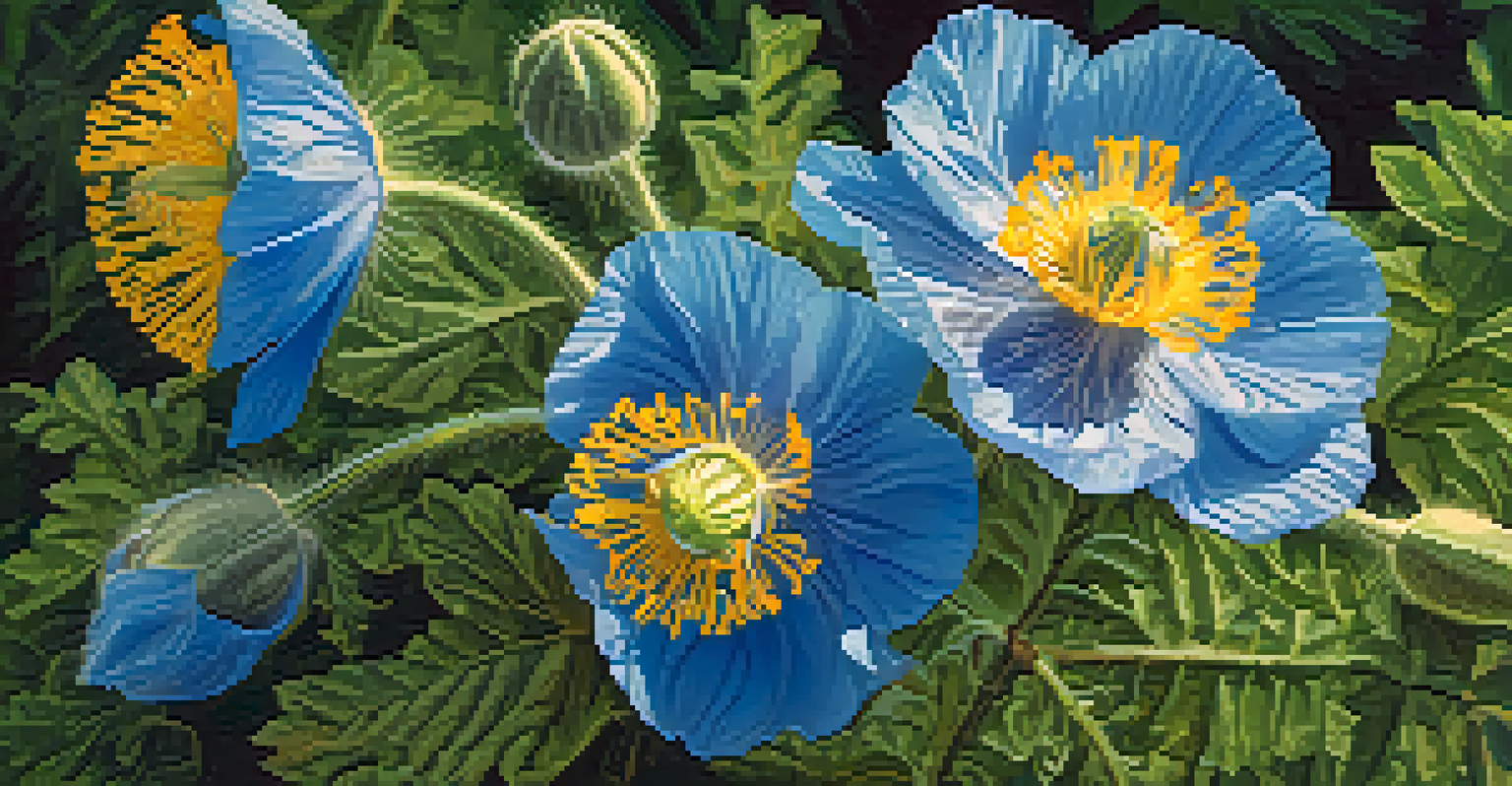Experience India's Endemic Plants on Nature Tours

Why India is a Haven for Endemic Plants
India's rich biodiversity is largely due to its varied climate and geography, which range from the Himalayan mountains to tropical rainforests. This diverse environment creates unique habitats that support a wide array of endemic plant species, meaning they are found nowhere else on Earth. These plants are not just beautiful; they play crucial roles in their ecosystems, supporting local wildlife and contributing to cultural practices.
The clearest way into the Universe is through a forest wilderness.
For instance, the iconic Neelakurinji blooms every 12 years in the Western Ghats, attracting nature lovers from around the world. This phenomenon highlights how endemic plants are tied to both ecological and social narratives, making them not just subjects of study but also part of community traditions. Each region in India offers a different set of endemic flora, waiting to be explored and appreciated.
By participating in nature tours, you can experience the beauty and complexity of these plants firsthand. Whether you’re trekking through the lush forests of Kerala or exploring the unique desert flora of Rajasthan, the chance to see these endemic species in their natural habitat is an unforgettable experience.
Top Locations for Experiencing Endemic Plants
When it comes to witnessing India's endemic plants, certain locations stand out for their rich biodiversity. The Western Ghats, a UNESCO World Heritage Site, is home to over 7,402 species of flowering plants, many of which are endemic. On a guided tour through this expansive mountain range, you can encounter the vibrant Strobilanthes kunthiana, known as Neelakurinji, along with many other unique species.

Another hotspot is the Andaman and Nicobar Islands, where the isolation has led to the evolution of distinct plant species. Here, you can find the rare and beautiful Andaman padauk, which showcases the islands’ unique charm. Nature tours in this region often include a combination of trekking and boat rides, allowing you to appreciate the stunning landscapes and the endemic plants that thrive there.
India's Unique Endemic Flora
India's diverse climates and landscapes create unique habitats for endemic plants that are vital to local ecosystems.
Don’t forget about the northeastern states of India, like Sikkim and Arunachal Pradesh, which boast a wide array of endemic species. Nature enthusiasts can hike through lush valleys and high-altitude areas, where they’ll encounter everything from rare orchids to giant rhododendrons. Each of these locations offers a distinct experience, making India a treasure trove for plant lovers.
The Importance of Endemic Plants in Ecosystems
Endemic plants play a pivotal role in maintaining the health of ecosystems. They often provide essential resources for local wildlife, including food and shelter, contributing to biodiversity. For example, the Himalayan blue poppy not only dazzles with its beauty but also supports various pollinators, showcasing how interconnected these species are within their habitats.
Look deep into nature, and then you will understand everything better.
Moreover, many endemic plants are adapted to specific environmental conditions, which allows them to thrive where other species cannot. This adaptability makes them important for ecosystem resilience, especially in the face of climate change. By understanding these plants, we can better appreciate the delicate balance of nature and the importance of preserving it.
Participating in nature tours focused on endemic plants can deepen your understanding of these ecological relationships. Guides often share fascinating stories about how local flora interacts with fauna, enriching your experience and fostering a greater appreciation for conservation efforts.
Engaging with Local Communities on Nature Tours
Nature tours centered on endemic plants often involve local communities, providing a richer, more immersive experience. These communities have traditional knowledge of the plants and their uses, which can include medicinal properties, culinary applications, and cultural significance. Engaging with locals allows travelers to learn about the plant life in a context that is both educational and respectful.
For instance, in the northeastern states, local tribes might share their traditional uses of the vibrant orchids found in the region. This not only enhances your understanding of the plants but also supports community-based tourism, helping to preserve both culture and nature. By participating in these tours, you contribute to the livelihoods of local people while gaining unique insights into their connection to the land.
Top Spots for Plant Enthusiasts
Key locations like the Western Ghats and Andaman Islands offer rich biodiversity, showcasing numerous endemic species.
Additionally, many tours incorporate workshops or demonstrations led by local artisans, showcasing how endemic plants are used in crafts and sustainable practices. This hands-on experience not only enriches your tour but also fosters a sense of connection with the broader ecosystem and its caretakers.
Best Time to Experience India's Endemic Flora
Timing is crucial when planning your nature tour to experience India's endemic plants at their best. Many species have specific blooming seasons, and knowing when to visit can significantly enhance your experience. For example, the Neelakurinji flowers typically bloom in August to October, drawing visitors eager to witness this natural spectacle.
In the Western Ghats, the monsoon season from June to September brings life to the region, resulting in lush greenery and vibrant blooms. This season is ideal for spotting various endemic plants, as the rain rejuvenates the landscape. However, it’s also essential to consider the potential for heavy rains and plan accordingly for safety and comfort.
On the other hand, if you're interested in alpine flora, the summer months from April to June are perfect for trekking in the Himalayas. This period offers clear views and the opportunity to see many endemic species in full bloom. Each season brings its own charm, making it possible to enjoy India's endemic plants year-round.
How to Choose a Nature Tour Focused on Endemic Plants
Selecting the right nature tour is crucial for your experience of India's endemic plants. Look for tours that specifically highlight botanical exploration, ensuring that they have knowledgeable guides who are well-versed in the region’s flora. Reading reviews and testimonials can provide insights into the tour’s focus and the guide's expertise.
Additionally, consider the group size and the company’s commitment to sustainability. Smaller groups often offer a more intimate experience, allowing for better interactions with guides and opportunities to ask questions. Sustainable practices, such as minimizing environmental impact and supporting local communities, are essential for preserving the delicate ecosystems you’ll be visiting.
Engagement with Local Cultures
Participating in nature tours allows travelers to connect with local communities and learn about the cultural significance of endemic plants.
Lastly, ensure the itinerary includes diverse locations known for their endemic flora. A well-rounded tour may combine hikes, educational sessions, and opportunities for photography, maximizing your chances of experiencing the unique plant life that India has to offer.
Conclusion: Embark on Your Journey with Nature Tours
Experiencing India's endemic plants through nature tours is an enriching adventure that offers both beauty and education. By immersing yourself in various ecosystems, you not only witness the unique flora but also gain insights into the importance of conservation and sustainable practices. Each location and plant species tells a story, waiting for you to discover it.
Nature tours provide a platform for connecting with local communities, learning about their traditions, and understanding the vital role endemic plants play in their lives. This journey is not just about seeing; it's about understanding and appreciating the intricate web of life that sustains us all.

So, pack your bags and prepare for an unforgettable exploration of India’s rich biodiversity. With every step, you’ll find a deeper connection to nature and a renewed appreciation for the endemic plants that make this country truly unique.